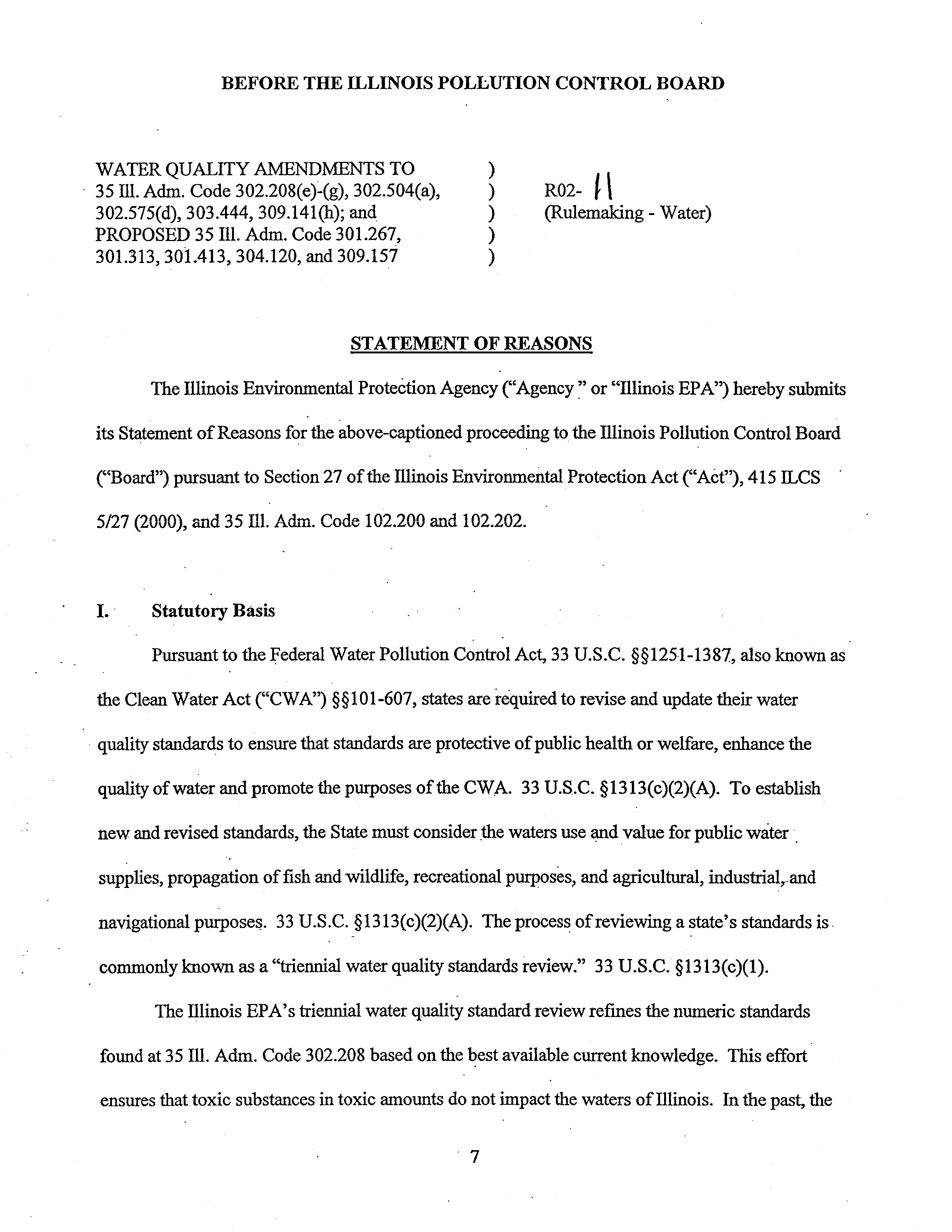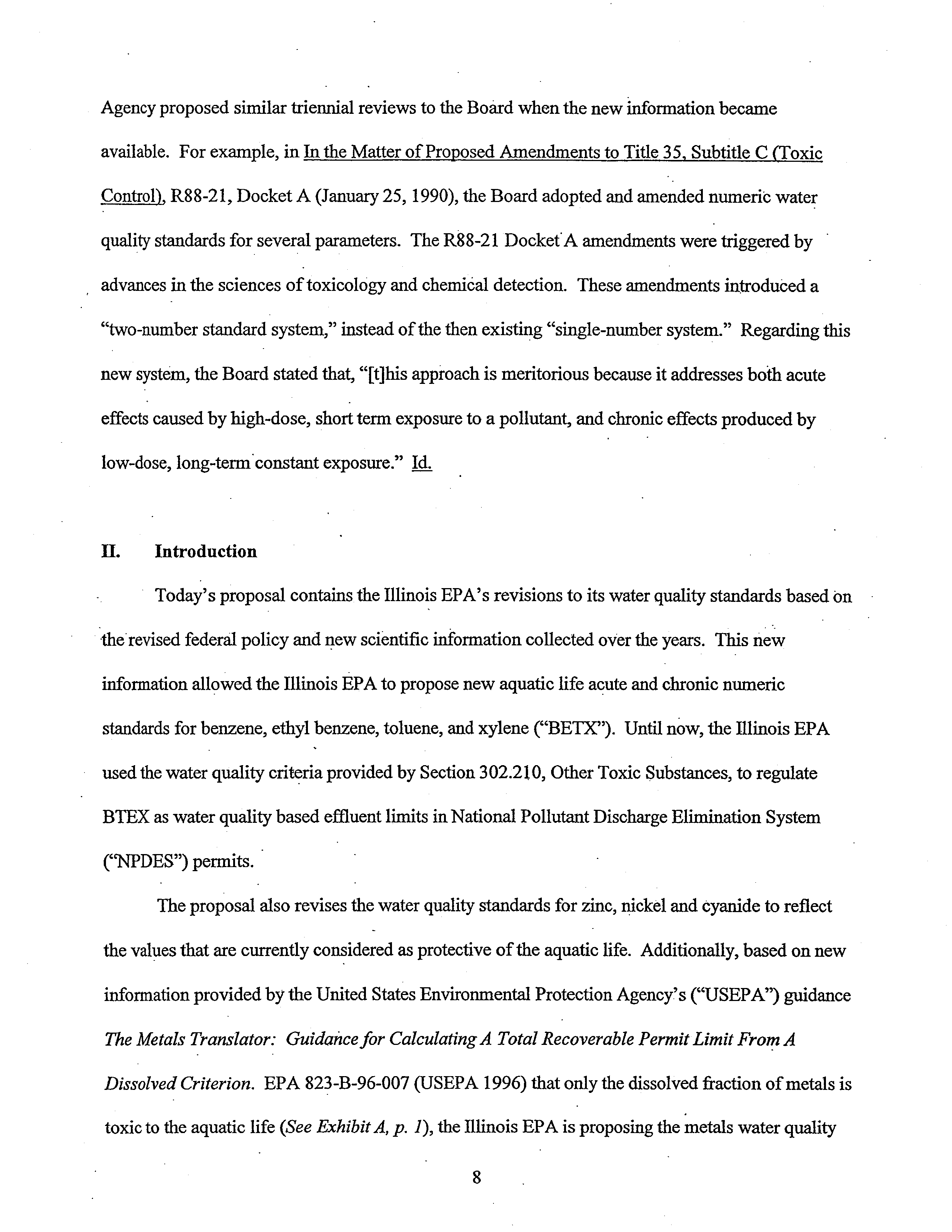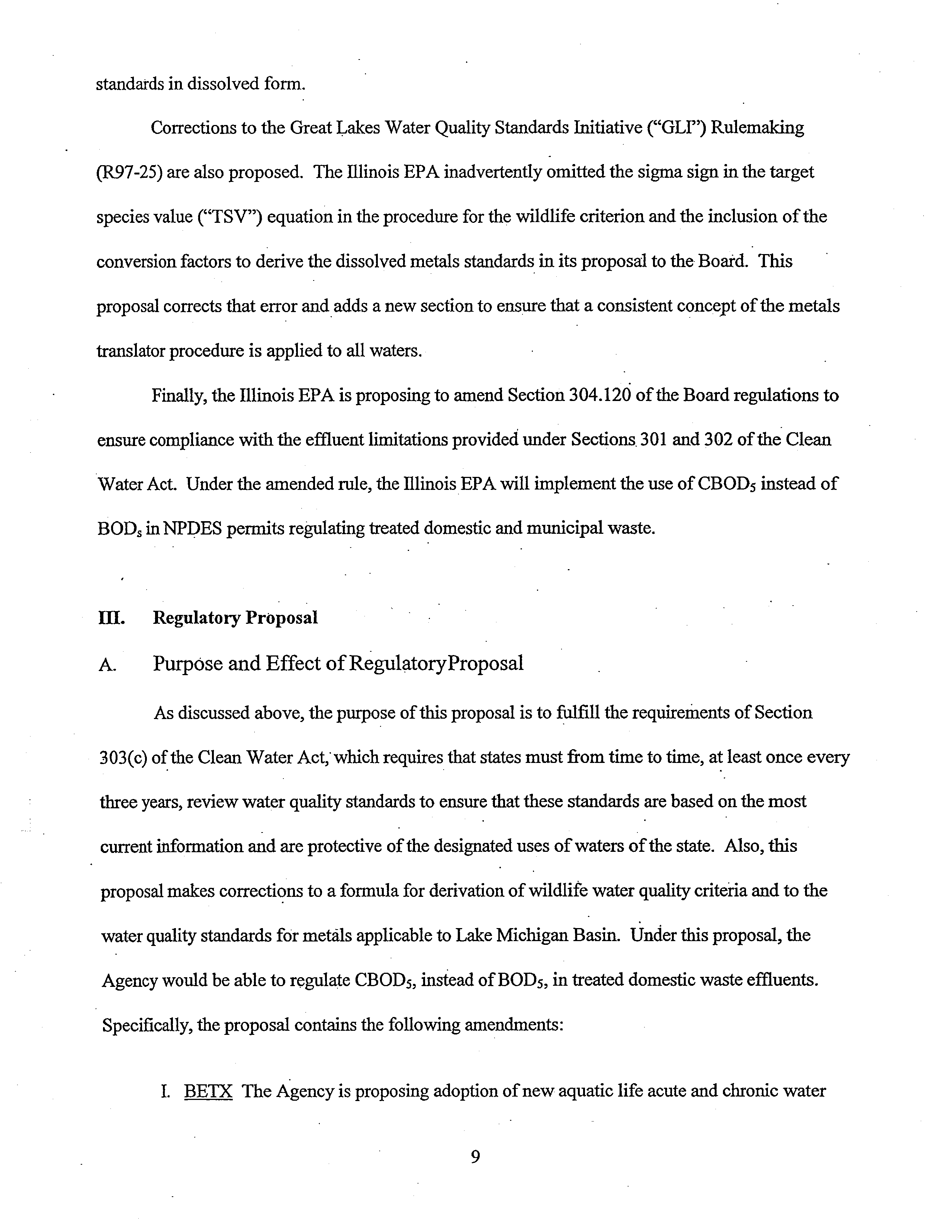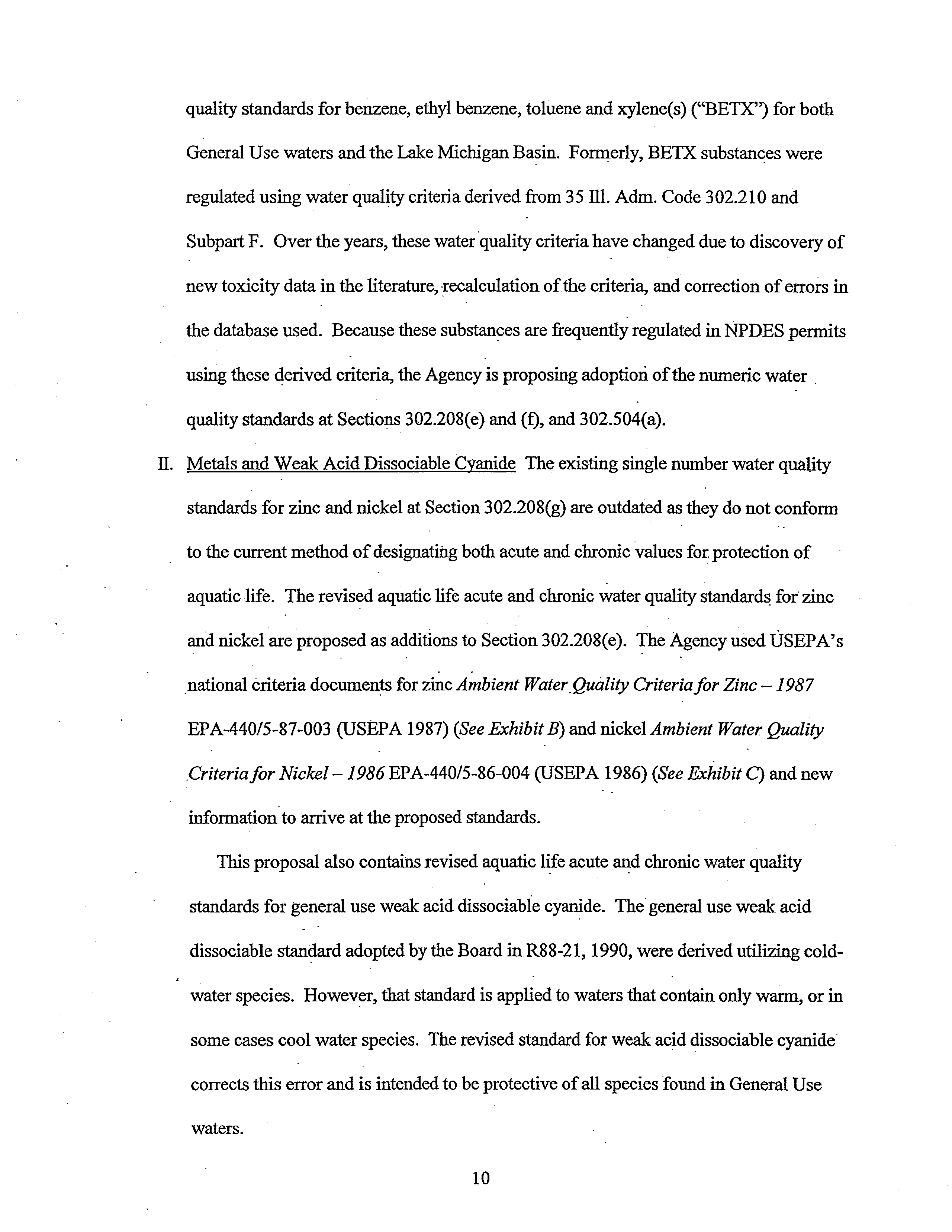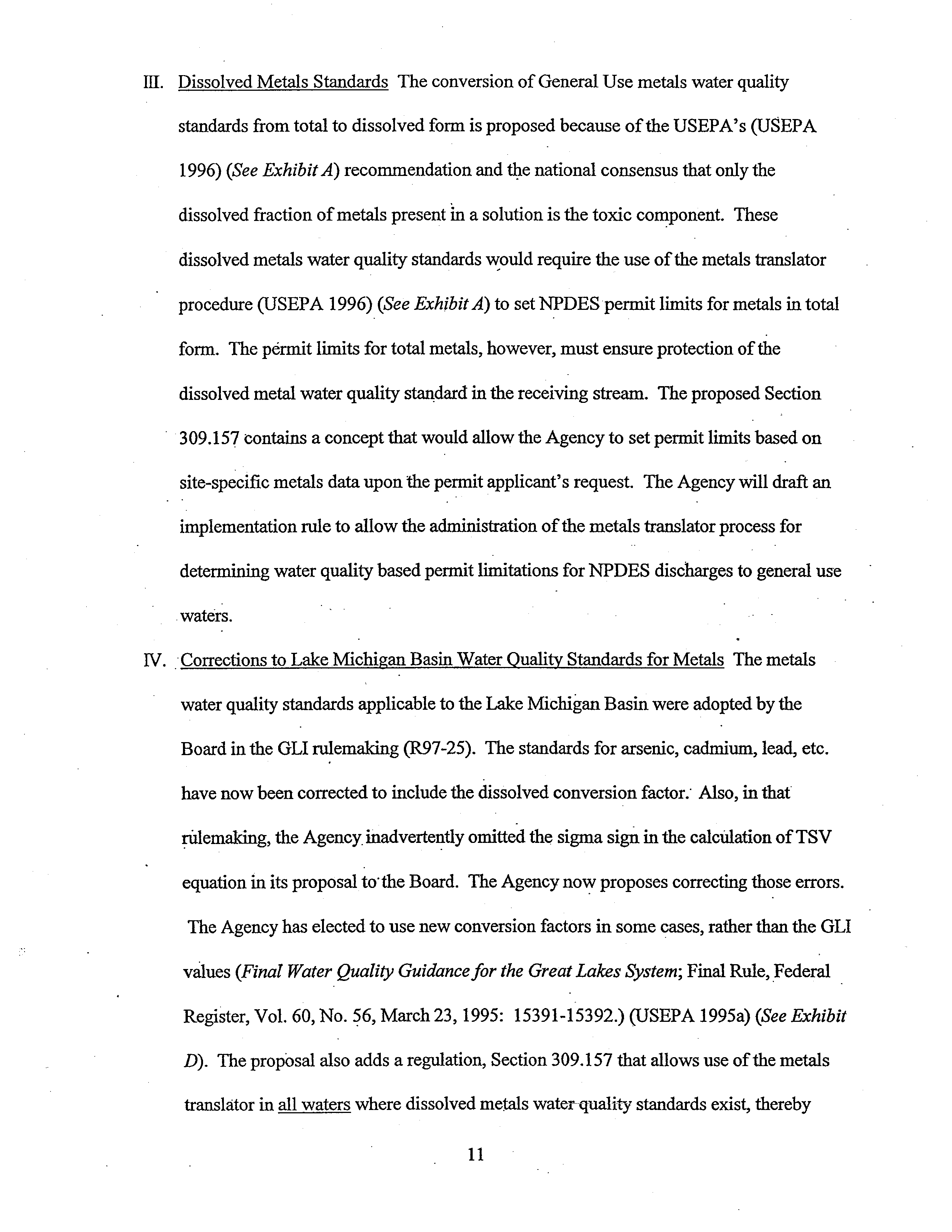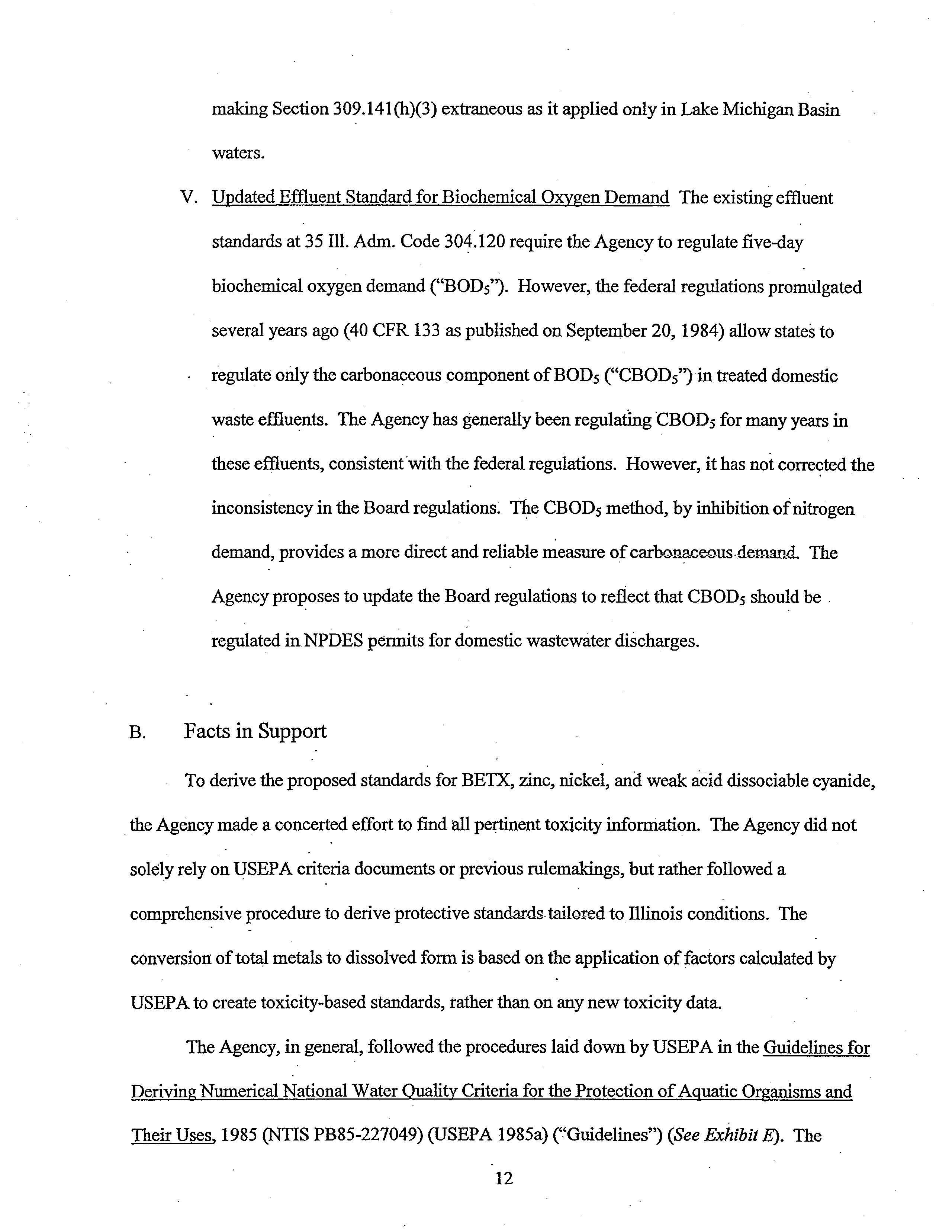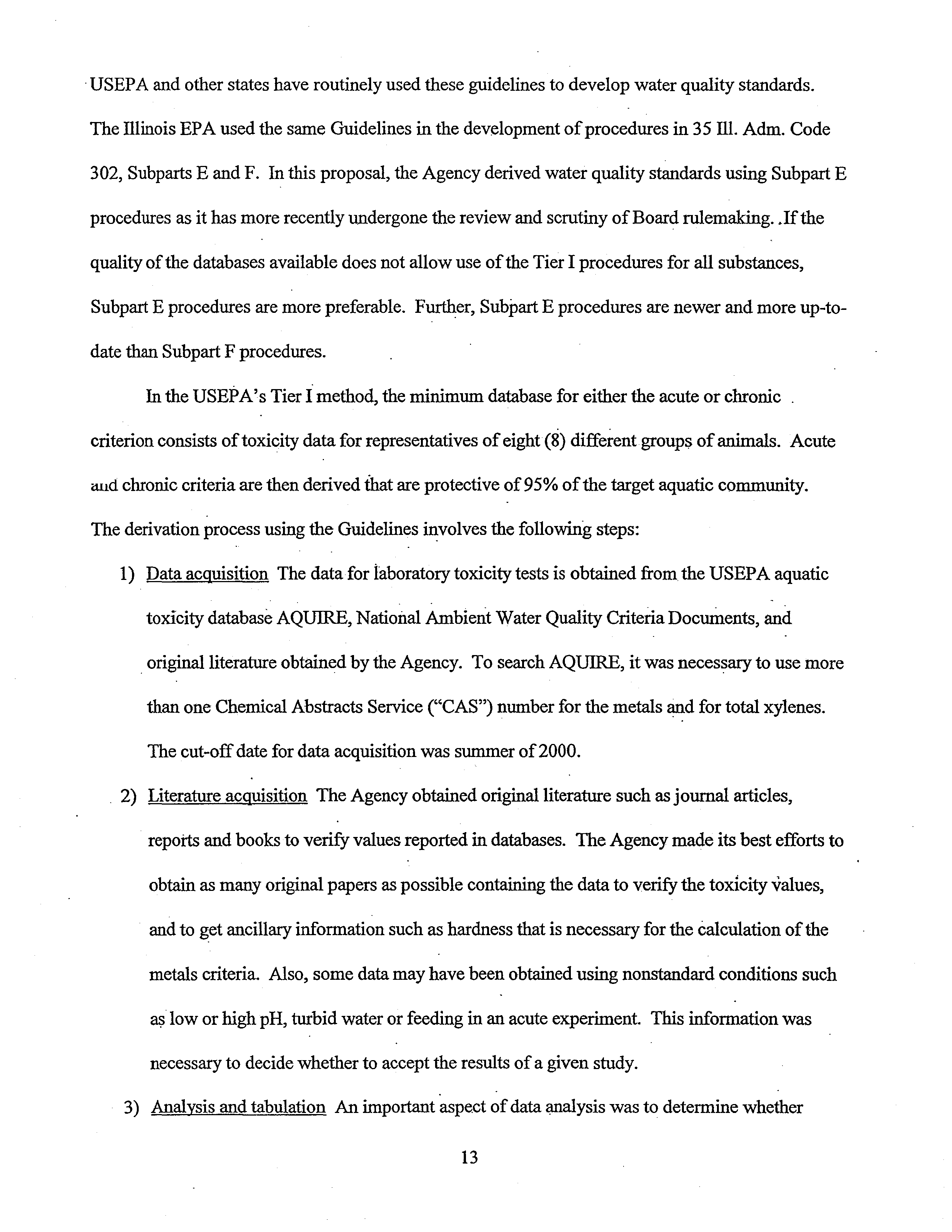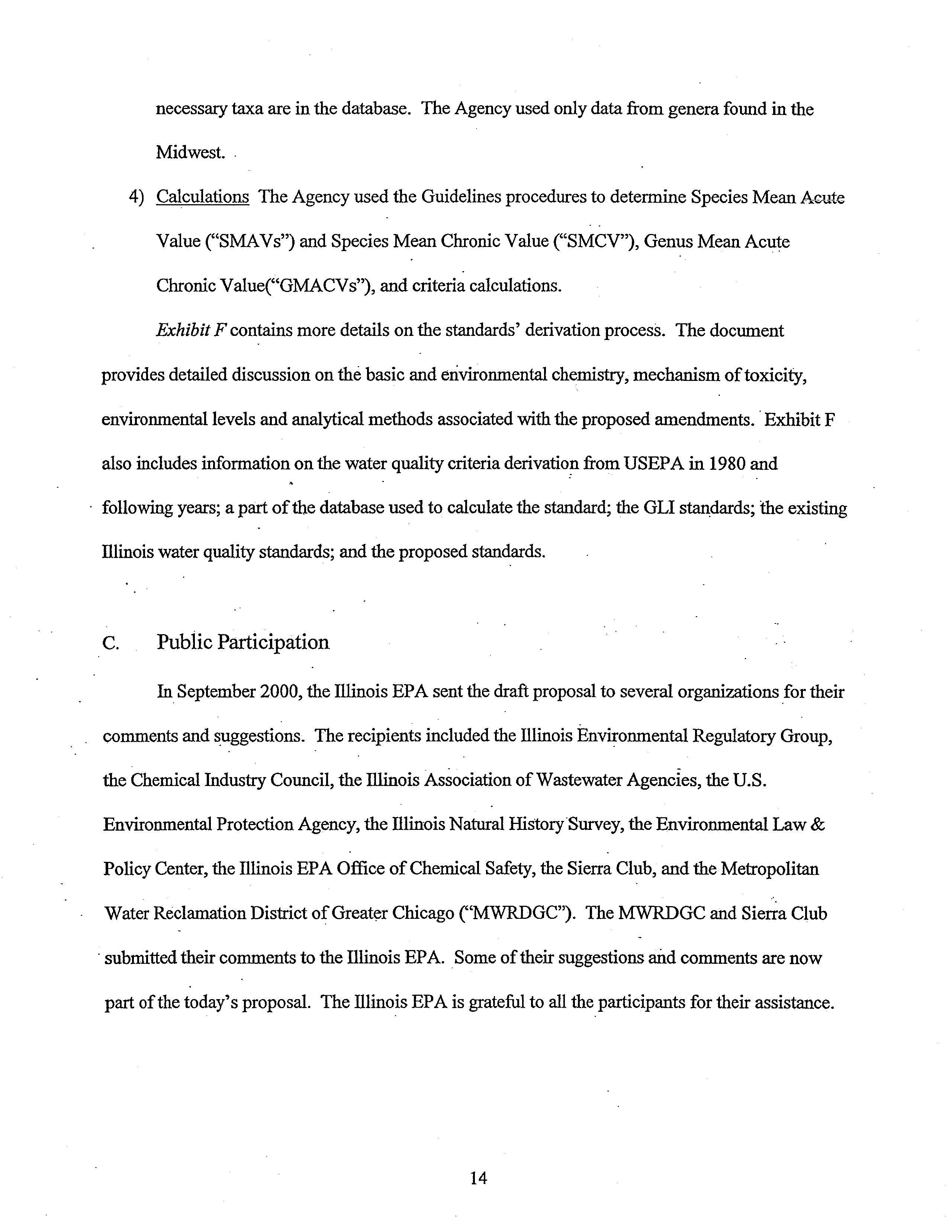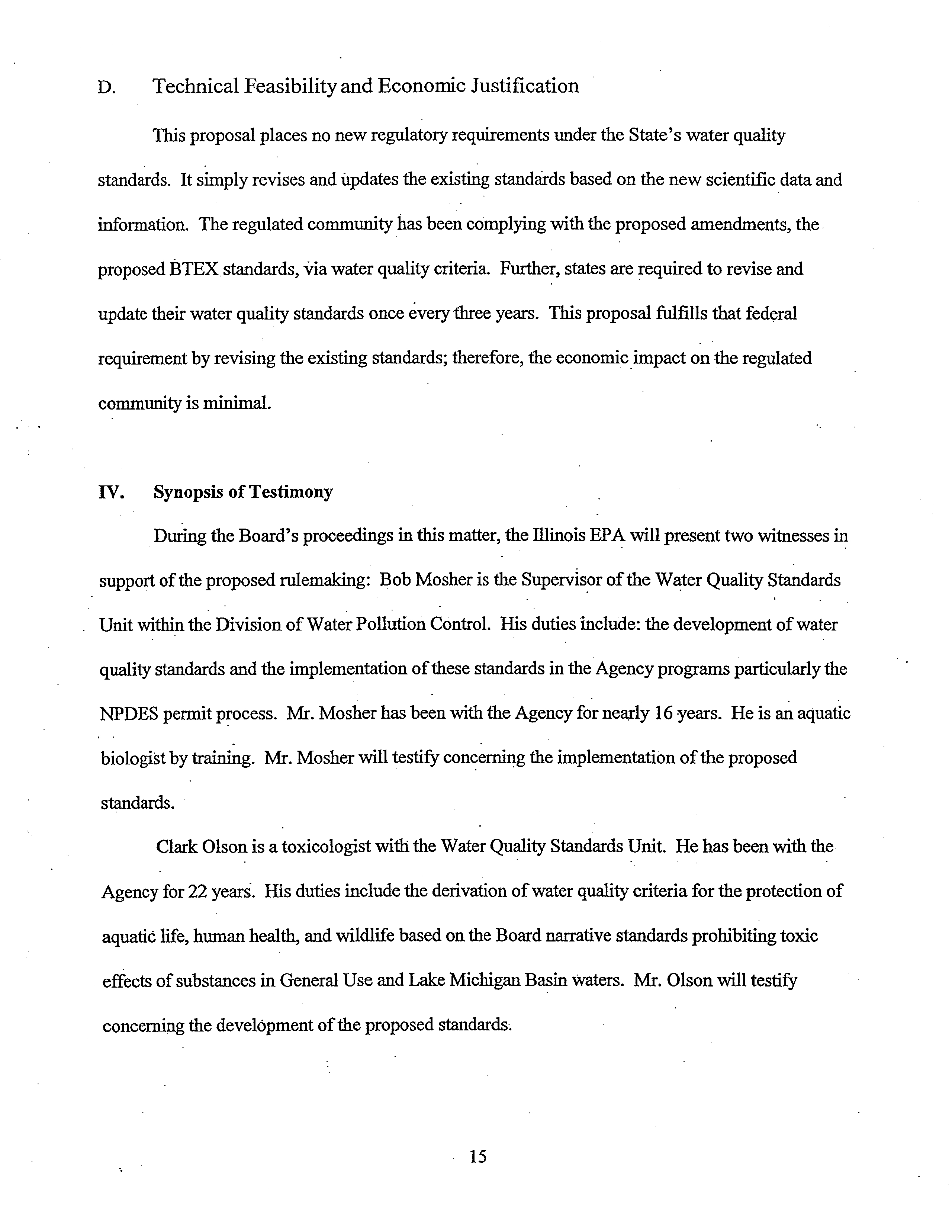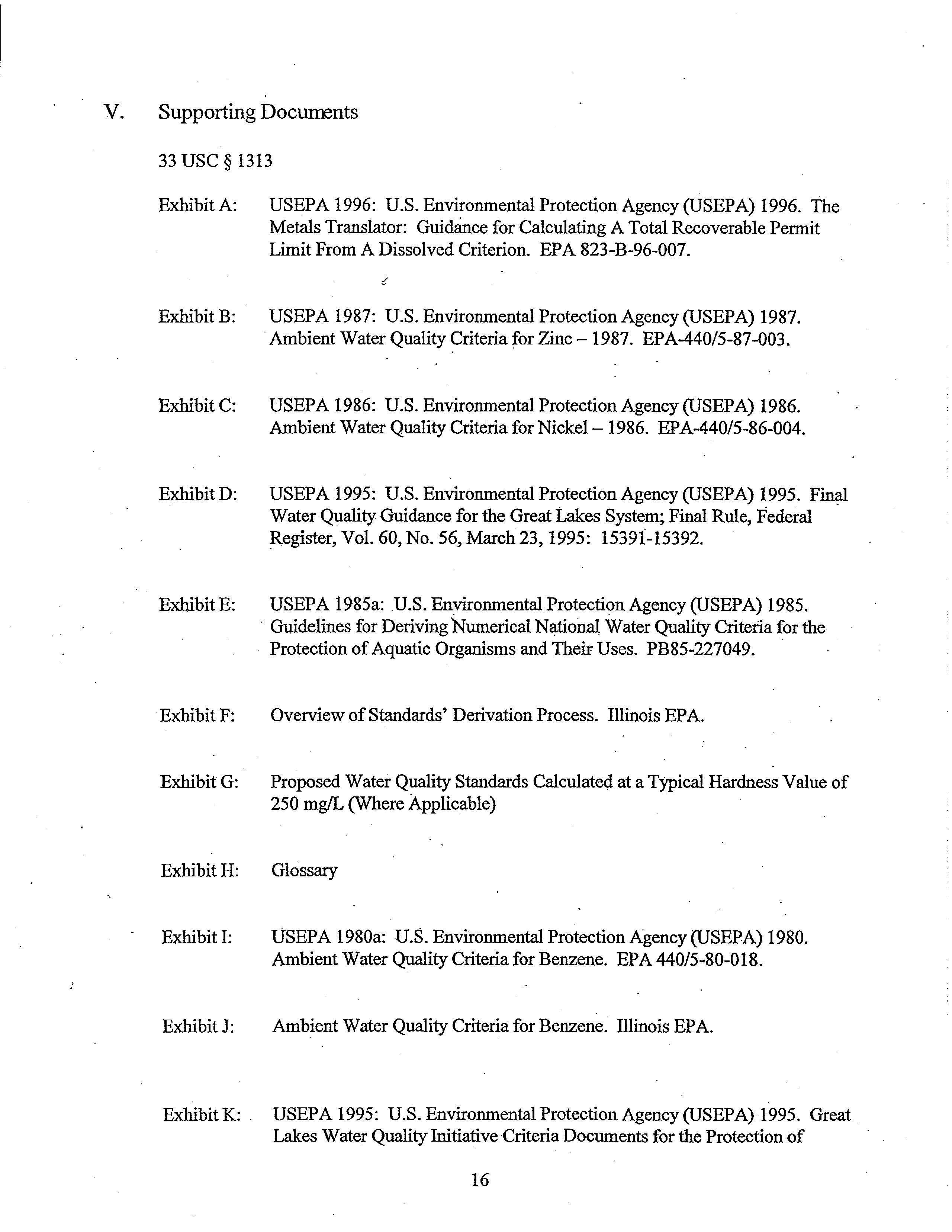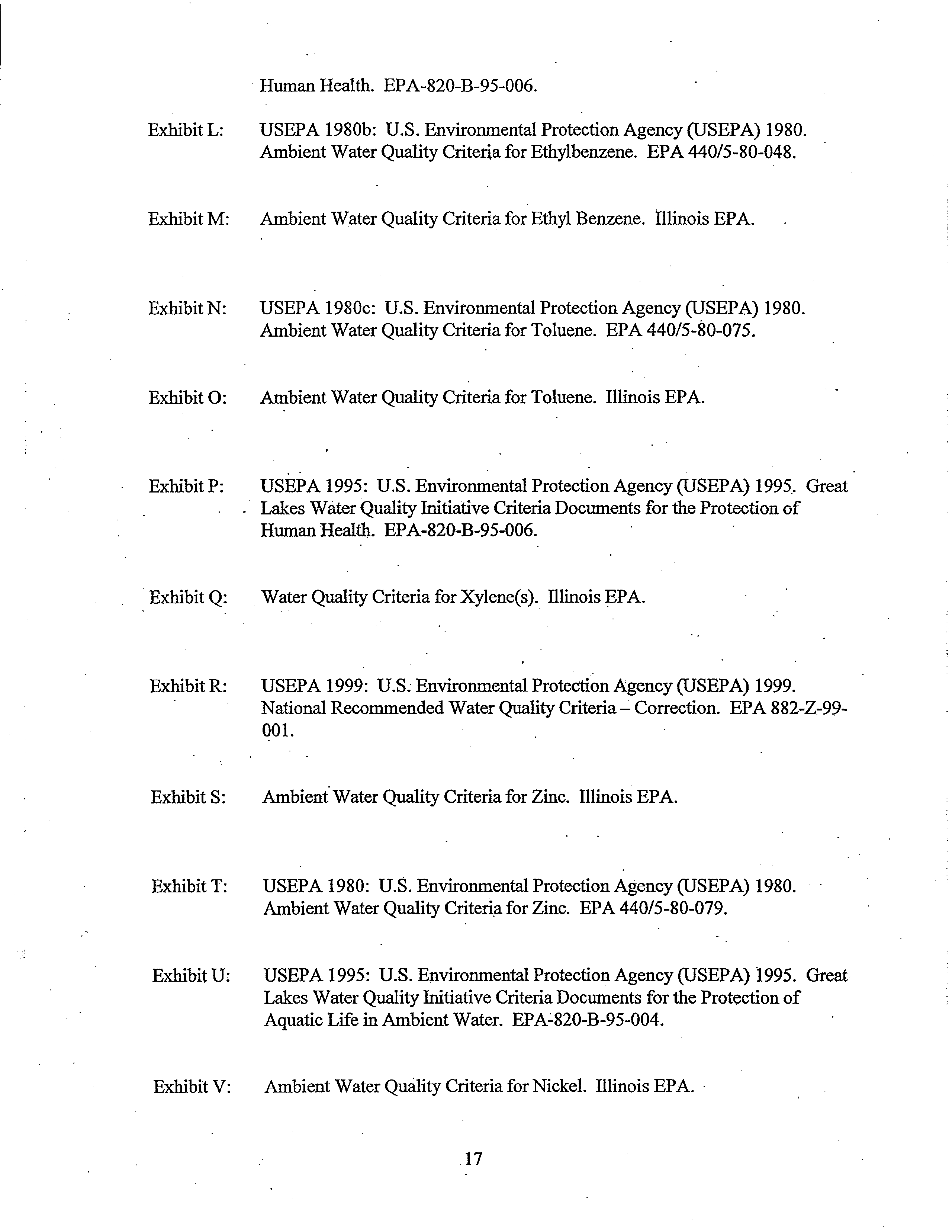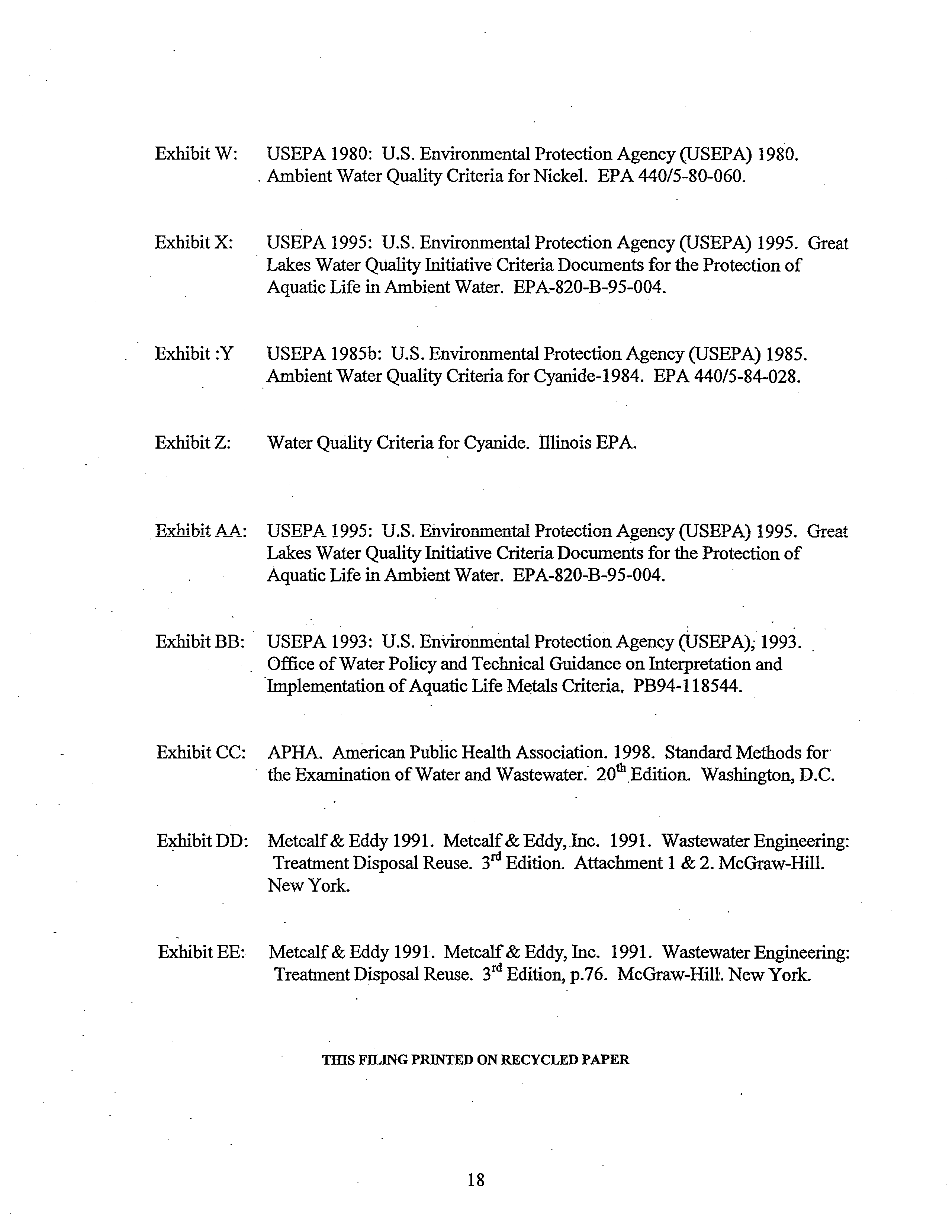BEFORE THE ILLINOIS POLLUTION
CONTROL BOARD
WATER QUALITY AMENDMENTS TO
)
35
Iii. Adm. Code 302.208(e)-(g),
302.504(a),
)
R02-
302.575(d), 303.444,
309.141(h); and
)
(Rulemaking
-
Water)
PROPOSED
35111. Adm. Code 301.267,
)
301.3 13, 301.413, 304.120,
and 309.157
)
STATEMENT OF REASONS
The Illinois Environmental Protection Agency(“Agency” or “Illinois EPA”) hereby submits
its Statement of Reasons for the above-captioned proceeding to the illinois Pollution Control Board
(“Board”) pursuant to
Section 27 ofthe illinois Environmental Protection Act (“Act”), 415 ILCS
5/27 (2000), and
35
111.
Adm. Code 102.200 and 102.202.
I.
Statutory Basis
Pursuant to the Federal Water Pollution Control Act, 33 U.S.C. §~1251-1387,
also known as
the Clean Water Act (“CWA”)
§ §
101-607, states are requiredto revise and update their water
quality standards to ensure that standards are protective ofpublic health or welfare, enhance the
quality ofwaterand promote the purposes ofthe CWA.
33 U.S.C.
§1313(c)(2)(A).
To establish
new and revised standards, the
State must considerthe waters use and value for public water
supplies, propagation offish and wildlife, recreational purposes, and agricultural, industrial,, and
navigational purposes.
33
U.S.C.
§
1313(c)(2)(A).
The process ofreviewing a state’s standards is
commonly known as a “triennial water quality standards review.”
33 U.S.C. §1313(c)(1).
The illinois EPA’s triennial waterquality standardreviewrefmes the numeric standards
found at 35 III. Adm. Code 302.208
based on the best available current knowledge.
This effort
ensures that toxic substances in toxic amounts do not impact the waters of Illinois.
In the past, the
7
Agency proposed similar triennial reviews to the Board whenthe new information became
available.
For example, in Inthe Matterof Proposed Amendments to Title
35,
Subtitle
C (Toxic
Control), R88-21, DocketA (January
25,
1990), the Board adopted and amended numeric water
quality standards for several parameters.
The R88-21 DocketA amendments were triggered by
advances in the sciences oftoxicology and chemióal detection.
These amendments introduôed a
“two-number standard system,” instead ofthe then existing “single-number system.”
Regarding this
new system, the Board stated that, “~tbis
approach is meritorious because it addresses both acute
effects caused by high-dose, short term exposure to a pollutant, and chronic effectsproduced by
low-dose, long-termconstant exposure.” j4~
II.
Introduction
•
Today’s proposal containsthe Illinois EPA’s revisions to its water quality standards based On
the revised federal policy and new scientific informationcollected over the years.
This new
information allowed the illinois EPA to propose new aquatic life acute and chronic numeric
standards for benzene,
ethyl benzene, toluene, and xylene (“BETX”).
Until now, the illinois EPA
usedthe water quality criteriaprovided by Section 302.210, Other Toxic Substances, to regulate
BTEX as water quality based effluent limits in National Pollutant Discharge Elimination System
(“NPDES”) permits.
The proposal also revises the water quality standards for zinc, nickel and cyanide to reflect
thevalues that are currently considered as protective ofthe aquatic life.
Additionally, based on new
information provided by the United States Environmental Protection Agency’s (“USEPA”) guidance
The Metals Translator:
Guidancefor CalculatingA Total Recoverable PermitLimit From A
Dissolved Criterion.
EPA 823-B-96-007 (USEPA 1996) that only the dissolved fraction ofmetals is
toxic to the aquatic life
(See ExhibitA, p.
1),
the Iffinois EPA is proposing themetals water quality
8
standards in dissolved form.
Corrections to the Great Lakes Water Quality Standards Initiative (“GLr’) Rulemaking
(R97-25) are also proposed.
The illinois EPAinadvertently omittedthe sigmasign in the target
species value (“TSV”) equation in the procedure for the wildlife criterion and the inclusion ofthe
conversionfactors to derive the dissolved metals standards in its proposal to the Board.
This
proposal corrects that error and adds a new section to ensure that a consistent concept ofthe metals
translator procedure is applied to all waters.
Finally, the Illinois EPA is proposing to amend Section 304.120 ofthe Board regulations to
ensure compliance withthe effluent limitations provided under Sections. 301
and 302 ofthe Clean
Water Act.
Under the amended rule, the illinois EPAwill implement the use ofCBOD5 instead of
BODS in NPDES permits regulating treated domestic and municipal waste.
III.
Regulatory Proposal
A.
Purpose
and Effect ofRegulatoryProposal
As discussed above, the purpose of this proposal is to fulfill the requirements ofSection
303(c) ofthe Clean Water Act, which requires that states must from time to time,
at least once every
three years, reviewwater quality standards to ensure that these standards are based on themost
current information and are protective ofthe designated uses ofwaters ofthe state.
Also, this
proposal makes corrections to a formulafor derivation ofwildlife water quality criteria andto the
water quality standards for metals applicable to Lake Michigan Basin.
Under this proposal, the
Agency would be able to regulate CBOD5, instead ofBOD5, in treated domestic waste effluents.
Specifically,the proposal contains the following amendments:
I.
BETX
The Agency is proposing adoption ofnew aquatic life acute and chronic water
9
quality standards for benzene, ethyl benzene, toluene and xylene(s) (“BETX”) for both
General Use waters and the Lake Michigan Basin.
Formerly, BETX substances were
regulated using water quality criteria derived from 35 Ill. Adm. Code 302.210 and
Subpart F.
Over the years, these water quality criteriahave changed due to discovery of
new toxicitydata in the literature, i~ecalculationofthe criteria, and correction of errors in
the database used.
Because these substances are frequently regulated in NPDES permits
using these derived criteria, the Agency is proposing adoption ofthe numeric water
quality standards at Sections 302.208(e) and (f), and
302.504(a).
II.
Metals and Weak Acid Dissociable Cyanide
Theexisting single numberwater quality
standards for zinc and nickel at Section 302.208(g) are outdated as they do not conform
to the current method of designating both acute and chronicvalues forprotection of
aquatic life.
Therevised aquatic life acute and chronic water quality standards for zinc
and nickel are proposed as additions to Section 302.208(e).
The Agency used USEPA’s
national criteriadocuments for zinc
Ambient Water Quality Criteriafor Zinc
—
1987
EPA-440/5-87-003 (USEPA 1987)
(SeeExhibit B)
and nickel
Ambient Water Quality
Criteriafor Nickel
—
1986
EPA-440/5-86-004 (USEPA 1986)
(SeeExhibit C)
and new
information to arrive at the proposed standards.
This proposal also contains revised aquatic life acute and chronic water quality
standards for general use weak aciddissociable cyanide.
The general use weak acid
dissociable standard adopted by the Board in R88-21,
1990, were derived utilizing cold-
water species.
However, that standard is applied to waters that contain only warm, or in
some cases cool water species.
The revised standard forweak aciddissociable cyanide
corrects this error and is intended to be protectiveofall species found in General Use
waters.
•
10
III.
Dissolved Metals Standards
The conversion ofGeneral Use metals water quality
standards from total to dissolved form is proposed because ofthe USEPA’s (USEPA
1996)
(See ExhibitA)
recommendation and the national consensus that only the
dissolved fraction ofmetals present in a solution is the toxic component.
These
dissolved metals water quality standards would require the use ofthe metals translator
procedure (USEPA 1996)
(See ExhibitA)
to
set NPDES permit limits for metals in total
form.
The permit limits for total metals, however, must ensure protection ofthe
dissolved metalwater quality standard in the receiving stream.
The proposed Section
309.157 contains a conceptthat would allowthe Agency to set permit limits based on
site-specificmetals data upon the permit applicant’s request.
The Agency will draft an
implementation rule to allow the administration ofthe metals translator process for
determining water quality based permit limitations for NPDES discharges to general use
waters.
•
IV.
:
Corrections to Lake Michigan Basin Water Quality Standards for Metals
The metals
water quality standards applicable to the Lake Michigan Basin were adopted by the
Board in the GLIrulemaking
(R97-25).
The standards for arsenic, cadmium, lead, etc.
have now been corrected to include the dissolved conversion factor:
Also, in that
rulemaking, theAgency,inadvertently omitted the sigma sign in the calculationofTSV
equation in its proposal to~
the Board.
The Agency now proposes correcting those errors.
TheAgency has electedto use new conversion factors in some cases, rather than the GLI
values
(Final Water Quality Guidancefor the GreatLakes System;
Final Rule, Federal
Register, Vol. 60, No. 56, March 23,
1995:
15391-15392.)
(USEPA 1995a)
(See
Exhibit
D).
The proposal
also adds a regulation, Section
309.157
that allows use ofthe metals
translator in all waters where dissolved metals water--qualitystandards exist, thereby
11
making Section 309.141(h)(3) extraneous as it applied onlyin Lake MichiganBasin
waters.
V.
Updated Effluent Standard for Biochemical Oxygen Demand
The existing effluent
standards at 35
111. Adm. Code 304.120 require the Agency to regulate five-day
biochemicaloxygen demand (“BOD5”).
However, the federal regulations promulgated
several years ago (40 CFR 133
as published on September 20,
1984) allow states to
regulate onlythe carbonaceous component ofBOD5 (“CBOD5”) in treated domestic
waste effluents.
The Agency has generallybeen regulating ‘CBOD5 for manyyears in
these effluents, consistent with the federal regulations.
However, it has not correctedthe
inconsistency in the Board regulations.
The CBOD5 method, by inhibition ofnitrogen
demand, provides a more direct and reliable measure of carbonaceous•demand.
The
Agency proposes to update the Board regulations to reflect that CBOD5 should be
-
regulated in NPDES permits for domestic wastewater discharges.
B.
Facts in Support
-
-
To derive the proposed standards for BETX, zinc, nickel, and weak acid clissociable cyanide,
the Agency made a concerted effort to find all pertinenttoxicity information.
The Agency did not
solely rely on USEPA criteria documents orprevious rulemakings, but rather followed a
comprehensive procedure to derive protective standards-tailored to illinois conditions.
The
conversion oftotal metals to
dissolved form is based on the application offactors calculated by
USEPA to create toxicity-based standards, tather thanon any newtoxicitydata.
The Agency, in general, followed the procedures laid down by USEPA in the Guidelines for
Deriving Numerical National Water Quality Criteria for the Protection ofAquatic Organisms and
Their Uses,
1985 (NTIS PB8S-227049) (USEPA
l985a) (“Guidelines”)
(See Exhibit K).
The
-
12
-
• USEPA and other states have routinely used these guidelines to develop water quality standards.
The illinois EPA used the same Guidelines in the developmentofprocedures in 35111. Adm. Code
302, Subparts E and F.
In this proposal, the Agency derivedwater quality standards using Subpart E
procedures as ithas more recently undergone the review and scrutiny ofBoard rulemaking. Jf the
quality ofthe databases available does not allow use ofthe Tier Iprocedures for all substances,
Subpart E procedures are more preferable.
Further, Subpart E procedures are newer and more up-to-
date than Subpart Fprocedures.
In theUSEPA’s TierI method, the minimum database for either the acute or chronic
criterion consists oftoxicitydata for representatives of eight (8) different groups ofanimals.
Acute
~uid
chronic criteriaare thenderived that are protective of
95
ofthe target aquatic community.
The derivation process using the Guidelines involves the following steps:
1)
Data acquisition
The datafor laboratory toxicitytests is obtained from the USEPA aquatic
toxicity database AQUIRE, National Ambient Water Quality CriteriaDocuments, and
original literature obtained by the Agency.
To search AQUIRE, it was necessaryto use more
than one Chemical Abstracts Service (“CAS”) numberfor themetals and for total xylenes.
The cut-offdatefor data acquisitionwas summer of2000.
-
2)
Literature acquisition
The Agency obtained original literature such asjournal articles,
reports and books to verify valuesreportedin databases.
The Agency made its best efforts to
obtain as many original papers as possible containingthe data to verifythe toxIcity i,alues,
and to get ancillary information such as hardnessthat is necessary for the calculation ofthe
metals criteria.
Also, some datamayhave beenobtained using nonstandard conditions such
as low orhigh pH, turbid water or feeding in an acute experiment.
This information was
necessary to decide whether to accept theresults ofa given study.
3)
Analysis and tabulation
An important aspect ofdata analysis was to determine whether
13
necessary taxa are in the database.
The Agency used only data from genera found in the
Midwest.
4)
Calculations
TheAgency used the Guidelines procedures to determine Species Mean Acute
Value (“SMAVs”) and Species Mean ChronicValue (“SMCV”), Genus Mean Acute
Chronic Value(”GMACVs”), and criteria calculations.
Exhibit F
contains more details on the standards’ derivation process.
The document
provides detailed discussion on the basic and environmental chemistry, mechanism oftoxicity,
environmental levels and analytical methods associated with the proposed amendments. ‘Exhibit F
also includes information on the water quality criteriaderivation from USEPA in 1980 and
•
followingyears; a part ofthe database used to calculate the standard; the GLI standards; the existing
illinois water quality standards; and the proposed standards.
C.
Public Participation
-
In September 2000, the Illinois EPA sent the draft proposal to several organizations fortheir
comments and suggestions.
The recipients included the illinois Environmental Regulatory Group,
the Chemical Industry Council, the illinois Association ofWastewater Agencies, the U.S.
Environmental Protection Agency, the Illinois Natural History Survey, the Environmental Law &
PolicyCenter, the Illinois EPA Office ofChemical Safety, the Sierra Club, and the Metropolitan
Water Reclamation District ofGreatçr Chicago (“MWRDGC”).
The MWRDGC and SierraClub
• submitted their comments to the illinois EPA.
Some oftheir suggestions and comments are now
part ofthe today’s proposal.
The illinois EPA is grateful to all the participants for their assistance.
14
D.
Technical Feasibility and Economic Justification
This proposal places no new regulatory requirements under the State’s water quality
standards.
It simply revises and updates the existing standards based on the new scientific data and
information.
The regulated communityhas been complying with the proposed amendments, the
-
proposed BTEX. standards, viawater quality criteria.
Further, states are required to revise and
update theirwater quality standards once every Three years.
This proposal fulfills that federal
requirementby revising the existing standards; therefore, the economic impact on the regulated
community is minimal.
IV.
Synopsis of Testimony
During the Board’s proceedings in this matter, the Illinois EPA will present two witnesses in
support ofthe proposed rulemaking:
Bob Mosher is the Supervisor ofthe Water Quality Standards
•
Unit withinthe Division ofWater Pollution Control.
His duties include: the development ofwater
quality standards and the implementation ofthese standards in the Agency programs particularly the
NPDES permit process.
Mr. Mosher has beenwiththe Agency fornearly
16 years.
He is an aquatic
biologist by training.
Mr. Mosherwill testify concerning the implementation ofthe proposed
standards.
Clark Olson is
a toxicologist withthe Water Quality
Standards Unit.
He
has beenwith the
Agency for 22 years.
His duties include the derivation ofwater quality criteria for the protection of
aquatic life, human health, and wildlife based on the Board narrative standards prohibiting toxic
effects ofsubstances in General Use and Lake Michigan Basin waters.
Mr. Olson will testify
concerning the developmentoftheproposed standards.
15
V.
Supporting Documents
33USC~1313
Exhibit A:
USEPA 1996:
U.S. Environmental Protection Agency (USEPA) 1996.
The
Metals Translator:
Guidance for Calculating A Total Recoverable Permit
Limit
From ADissolved Criterion.
EPA 823-B-96-007.
Exhibit B:
USEPA 1987:
U.S. Environmental Protection Agency (USEPA) 1987.
-
Ambient Water Quality Criteriafor Zinc
—
1987.
EPA-440/5-87-003.
Exhibit C:
USEPA 1986:
U.S. Environmental Protection Agency (USEPA) 1986.
Ambient Water Quality Criteria forNickel
—
1986.
EPA-440/5-86-004.
Exhibit D:
USEPA
1995:
U.S. Environmental Protection Agency (USEPA)
1995.
Final
Water Quality Guidance for the Great Lakes System; Final Rule, Federal
Register, Vol. 60, No.
56,
March 23,
1995:
15391-15392.
Exhibit E:
USEPA l985a:
U.S. Environmental Protection Agency (USEPA)
1985.
•
Guidelinesfor Deriving Numerical National Water Quality Criteria forthe
-
Protection of Aquatic Organisms and Their Uses.
PB85-227049.
Exhibit F:
Overview ofStandards’ Derivation Process.
Illinois EPA.
Exhibit G:
Proposed Water Quality Standards Calculated at a Typical Hardness Value of
250 mgfL (WhereApplicable)
Exhibit H:
Glossary
Exhibit I:
USEPA 1980a:
U.S. Environmental Protection Agency (USEPA) 1980.
Ambient Water Quality Criteria for Benzene.
EPA 440/5-80-018.
Exhibit J:
Ambient Water Quality Criteria for Benzene.
Illinois EPA.
Exhibit K:
-
USEPA
1995:
U.S. Environmental Protection Agency (USEPA)
1995.
Great
Lakes Water Quality Initiative CriteriaDocuments for the Protection of
16
Human Health.
EPA-820-B-95-006.
Exhibit L:
Exhibit M:
Exhibit N:
USEPA 1980b:
U.S.
Environmental Protection Agency (USEPA) 1980.
Ambient Water Quality Criteriafor Ethylbenzene.
EPA 440/5-80-048.
Ambient Water Quality Criteria for Ethyl Benzene.
illinois EPA.
USEPA 1980c:
U.S. Environmental Protection Agency (USEPA) 1980.
Ambient Water Quality Criteria forToluene.
EPA
440/5-80-075.
Exhibit
0:
Ambient Water Quality Criteria forToluene.
Illinois EPA.
Exhibit P:
USEPA 1995:
U.S.
Environmental Protection Agency (USEPA)
1995,.
Great
•
-
Lakes Water Quality Initiative Criteria Documents for the Protection of
Human Health.
EPA-820-B-95-006.
Exhibit
Q:
Water Quality Criteria for Xylene(s).
illinois EPA.
Exhibit R:
USEPA 1999:
U.S;
Environmental Protection Agency (USEPA) 1999.
•
National Recommended Water Quality Criteria
—
Correction.
EPA 882-Z-99-
001.
Exhibit S:
Ambient Water Quality Criteriafor Zinc.
illinois EPA.
Exhibit T:
USEPA 1980:
U.S.
Environmental Protection Agency (USEPA) 1980.
Ambient Water Quality Criteriafor Zinc.
EPA 440/5-80-079.
Exhibit U:
Exhibit V:
USEPA 1995:
U.S. Environmental Protection Agency (USEPA) 1995.
Great
Lakes Water Quality Initiative Criteria Documents for the Protectionof
Aquatic Life in Ambient Water.
EPA~820-B-95-004.
Ambient Water Quality CriteriaforNickel.
Illinois EPA.
•
•
17
Exhibit W:
USEPA 1980:
U.S. Environmental Protection Agency (USEPA) 1980.
Ambient Water Quality Criteria forNickel.
EPA 440/5-80-060.
Exhibit X:
•
USEPA 1995:
U.S. Environmental Protection Agency (USEPA) 1995.
Great
Lakes Water Quality Initiative Criteria Documents for the Protectionof
•
Aquatic Life in Ambient Water.
EPA-820-B-95-004.
Exhibit :Y
USEPA l985b:
U.S. Environmental Protection Agency (USEPA) 1985.
Ambient Water Quality Criteria for Cyanide-1984.
EPA 440/5-84-028.
Exhibit Z:
Water Quality Criteria for Cyanide.
illinois EPA.
Exhibit AA:
Exhibit
BB:
Exhibit
CC:
Exhibit DD:
Exhibit EE:
USEPA
1995:
U.S. Enviroiunentai Protection Agency (USEPA~
1995.
Great
Lakes Water Quality Initiative CriteriaDocuments for the Protection of
Aquatic Life in Ambient Water.
EPA-820-B-95-004.
-
USEPA 1993:
U.S.
Environmental Protection Agency (USEPA), 1993.
Office of Water Policyand Technical Guidance on Interpretation and
‘Implementation ofAquatic Life Metals Criteria.
PB94-l 18544.
APHA.
American Public Health Association.
1998.
Standard Methods for
the Examination ofWater and Wastewater
20th,Edition.
Washington, D.C.
Metcalf& Eddy 1991.
Metcalf & Eddy, Inc.
1991.
WastewaterEngineering:
Treatment Disposal Reuse.
3rd
Edition.
Attachment 1
& 2. McGraw-Hill.
New York.
Metcalf & Eddy
1991-.
Metcalf& Eddy, Inc.
1991.
WastewaterEngineering:
Treatment Disposal Reuse.
3’~
Edition, p.’16.
McGraw-Hill. NewYork.
-
TIllS
FILING
PRINTED ON
RECYCLED PAPER
18
